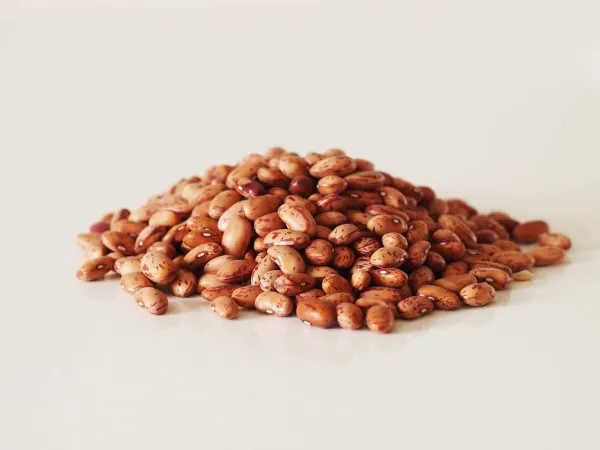Access our First Foods® Database in the Solid Starts App.
Learn moreCranberry Bean
Legume
Age Suggestion
6 months
Iron-Rich
Yes
Common Allergen
No

When can babies have cranberry beans?
Cranberry beans may be introduced as soon as baby is ready to start solids, which is generally around 6 months of age.
Cranberry bean is believed to have originated in South America, where it was likely bred from the cargamanto bean, a popular bean in Colombia. Colonization and trade introduced the bean to other regions of the world, where new legumes were cultivated from heirloom seeds. As a result, there are many varieties of cranberry bean, including alubia pinta, barbunya, borlotti, frijoles romanos, gadra, rosecoco, and saluggia.
How do you serve cranberry beans to babies?
Every baby develops on their own timeline, and the suggestions on how to cut or prepare particular foods are generalizations for a broad audience.
6 months old +:
Crush or blend cooked cranberry beans into a textured mash or smooth paste. To add nutrition, stir in breast milk, formula, olive oil, or yogurt. Start with a small amount and gradually increase portion size to minimize any digestive discomfort. Let baby scoop the mash or paste, and if help is needed, pre-load a spoon or thinly spread some mash on a resistive food like a teething rusk in the mash. Alternatively, share cranberry beans from your chili, pasta, salad, or stew. Simply pick out some of the beans and mash them for baby.
9 months old +:
Babies with a developing pincer grasp (where the thumb meets the pointer finger) may graduate to whole, cooked cranberry beans that have been flattened between your thumb and finger. Alternatively, continue serving mashed or pureed cranberry beans.
12 months old +:
By this age, toddlers should be able to handle whole cranberry beans that are fully cooked until soft. To encourage self-feeding with utensils, spear a cranberry bean with an age-appropriate fork and lay the utensil next to the food for the child to try to pick up. If help is needed, pass the utensil in the air for the child to grab from you.
Our Nutrient Cheat Sheet is ideal for keeping on the fridge for a quick reference of which babies need most.
Videos
Are cranberry beans a choking hazard for babies?
Yes. Cranberry beans are small, rounded, and can be firm, especially when raw or undercooked, qualities that can increase the risk of choking. To reduce the risk, prepare and serve cranberry beans in an age-appropriate way. As always, make sure you create a safe eating environment and stay within an arm’s reach of baby during meals. For more information on choking, visit our sections on gagging and choking and familiarize yourself with the list of common choking hazards.
Are cranberry beans a common allergen?
No. Cranberry beans are not a common food allergen. Bean allergies have been reported in some patients with allergies to other legumes, including peanut and soybean (which are common food allergens). However, being allergic to one type of legume does not necessarily mean that an individual will be allergic to others, although the risk of more than one legume allergy can increase. Fortunately, most individuals with peanut or soy allergy are able to tolerate other legumes just fine.
Individuals with allergies to birch tree pollen and/or Oral Allergy Syndrome (also called pollen-food allergy syndrome) may be sensitive to legumes, such as cranberry beans. Oral Allergy Syndrome typically results in short-lived itching or burning in the mouth and is unlikely to result in a dangerous reaction.
As you would when introducing any new food, start by offering a small quantity for the first few servings. If there is no adverse reaction, gradually increase the quantity over future meals.
Are cranberry beans healthy for babies?
Yes. Cranberry beans are packed with protein, carbohydrates, and fiber. They provide an array of important micronutrients that often are low in the diets of young children, such as iron, zinc, folate, choline, and vitamin B6. Collectively, these nutrients support healthy blood, strong immune systems, and thriving brains. Plus, they’re rich in antioxidants to support the body’s resilience against stressors.
★Tip: If buying fresh cranberry beans in the pod (not dried or canned beans), look for pods that look full and pump. Their shelf life is relatively short and they last in the fridge for a couple of days.
Are the lectins in cranberry beans safe for babies?
Yes. Often called anti-nutrients, these naturally-occurring plant compounds (including lectins, oxalates, and phytates) break down during the soaking and cooking process and are generally harmless in healthy people when consumed as part of a balanced diet. Lectins and oxalates can even offer health benefits, such as antioxidant and anti-cancer properties.
Do cranberry beans need to be soaked before cooking?
No, although soaking dried cranberry beans in water can help reduce cooking time, reduce lectin content, reduce the levels of a gas-producing carbohydrate, raffinose, and help improve overall digestibility of the bean and its key nutrients.
Here are a couple of soaking methods:
Overnight soak: Use a ratio of 1 lb (454 g) of dried beans and 10 c (2 ½ liter) water, and soak the beans in water for 4 or more hours or overnight. Drain and rinse the beans prior to cooking.
Hot soak method: Use a ratio of 1 lb (454 g) of dried beans and 10 c (2 ½ liter) water, and bring the mixture to a boil for 2-3 minutes. Turn off the heat, then soak for a few hours. Drain and rinse the beans prior to cooking.
Our Team
Written by
Expert Tips Delivered to Your Inbox
Sign up for weekly tips, recipes and more!





